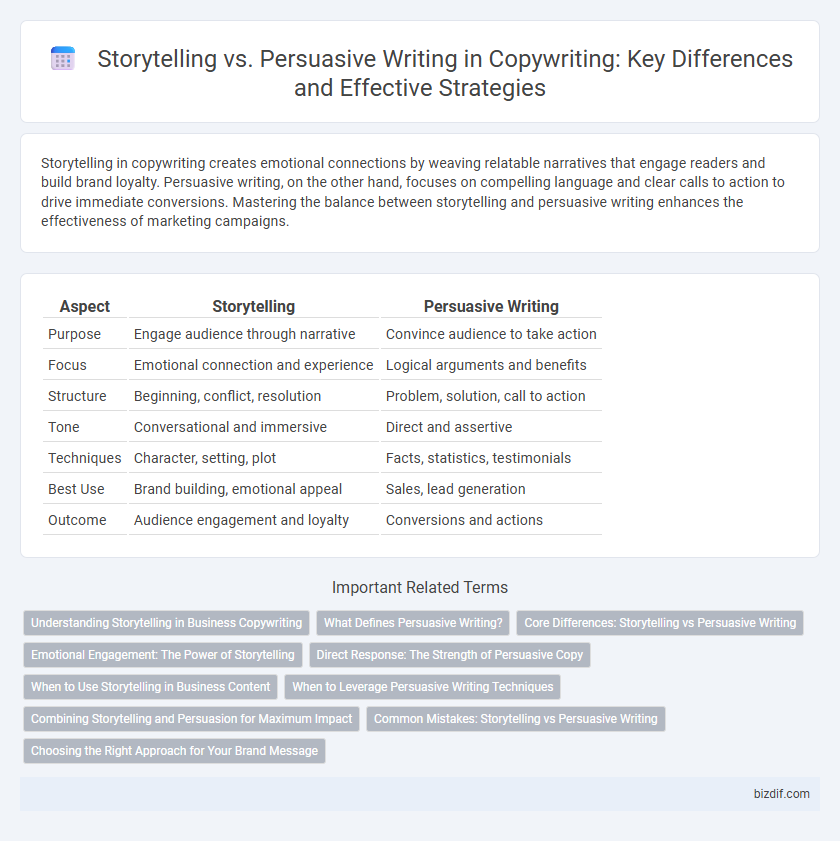Storytelling in copywriting creates emotional connections by weaving relatable narratives that engage readers and build brand loyalty. Persuasive writing, on the other hand, focuses on compelling language and clear calls to action to drive immediate conversions. Mastering the balance between storytelling and persuasive writing enhances the effectiveness of marketing campaigns.
Table of Comparison
| Aspect | Storytelling | Persuasive Writing |
|---|---|---|
| Purpose | Engage audience through narrative | Convince audience to take action |
| Focus | Emotional connection and experience | Logical arguments and benefits |
| Structure | Beginning, conflict, resolution | Problem, solution, call to action |
| Tone | Conversational and immersive | Direct and assertive |
| Techniques | Character, setting, plot | Facts, statistics, testimonials |
| Best Use | Brand building, emotional appeal | Sales, lead generation |
| Outcome | Audience engagement and loyalty | Conversions and actions |
Understanding Storytelling in Business Copywriting
Storytelling in business copywriting creates emotional connections by weaving narratives that resonate with the audience's values and experiences. It leverages characters, conflict, and resolution to make brand messages memorable and relatable, enhancing customer engagement. Effective storytelling drives trust and loyalty by humanizing products or services, setting the foundation for persuasive calls to action.
What Defines Persuasive Writing?
Persuasive writing is defined by its strategic use of rhetorical techniques and emotional appeals to convince readers to adopt a specific viewpoint or take a desired action. It incorporates clear arguments supported by evidence, calls to action, and persuasive language tailored to the target audience's values and interests. This style prioritizes clarity, urgency, and motivational triggers to influence decision-making effectively.
Core Differences: Storytelling vs Persuasive Writing
Storytelling in copywriting uses narrative techniques to engage emotions, build connections, and create memorable brand experiences, emphasizing characters, plot, and relatable scenarios. Persuasive writing focuses on convincing the audience with clear calls to action, emphasizing benefits, features, and logical appeals to drive conversions and sales. The core difference lies in storytelling's emotional engagement versus persuasive writing's direct influence on decision-making.
Emotional Engagement: The Power of Storytelling
Storytelling leverages narrative techniques to create emotional engagement by tapping into readers' empathy, making brand messages more relatable and memorable. Persuasive writing focuses on logic and benefits to prompt action, but storytelling's use of characters, conflict, and resolution fosters deeper connections and drives long-term loyalty. Emotional engagement through storytelling increases conversion rates by aligning consumer values with brand identity.
Direct Response: The Strength of Persuasive Copy
Persuasive copy in direct response marketing drives immediate action by appealing to the reader's emotions and logical triggers, leveraging strong calls-to-action and clear benefits. Unlike storytelling, which builds engagement through narrative and emotional connection, persuasive writing prioritizes concise, compelling messages tailored to convert prospects into customers quickly. Key elements such as urgency, value propositions, and social proof enhance the effectiveness of persuasive copy in generating measurable results.
When to Use Storytelling in Business Content
Storytelling in business content is most effective when aiming to build emotional connections and enhance brand identity by illustrating real-life examples or customer experiences. It works best for engaging audiences, making complex ideas relatable, and fostering trust through narratives that resonate with target demographics. Use storytelling when the goal is to inspire action through empathy rather than presenting straightforward sales arguments.
When to Leverage Persuasive Writing Techniques
Persuasive writing techniques should be leveraged when the primary goal is to influence the audience's decision-making process, such as in sales copy, call-to-actions, or conversion-focused content. This approach uses emotional triggers, strong value propositions, and clear benefits to motivate immediate responses or changes in behavior. Employing persuasive writing is essential in contexts where driving action, boosting engagement, or increasing sales is critical.
Combining Storytelling and Persuasion for Maximum Impact
Combining storytelling and persuasive writing harnesses emotional engagement alongside clear calls to action, creating compelling narratives that resonate and convert. Effective integration uses relatable characters and vivid scenarios to illustrate key benefits, making arguments memorable and impactful. This approach boosts audience connection, trust, and motivation, driving higher conversion rates in marketing campaigns.
Common Mistakes: Storytelling vs Persuasive Writing
Confusing storytelling with persuasive writing often leads to ineffective copy by overloading emotional elements without clear calls to action. A common mistake is neglecting persuasive techniques like urgency and social proof when crafting stories, which weakens conversion potential. Successful copy integrates narrative appeal with strategic persuasion to balance engagement and motivation.
Choosing the Right Approach for Your Brand Message
Storytelling captivates audiences by creating emotional connections and memorable brand narratives that boost engagement and loyalty. Persuasive writing drives immediate action through clear calls-to-action and benefit-focused language tailored to the target audience's needs. Selecting the right approach depends on your brand's goals: use storytelling for brand awareness and long-term relationships, and persuasive writing for conversions and sales growth.
Storytelling vs Persuasive Writing Infographic

 bizdif.com
bizdif.com